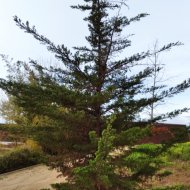Care of the tree Cupressus macrocarpa or Monterey cypress |
|
The genus Cupressus, family Cupressaceae, comprises about 30 species of trees native to Asia, Europe and America. Some species are: Cupressus macrocarpa, Cupressus funebris, Cupressus sempervirens, Cupressus sargentii, Cupressus arizonica, Cupressus atlantica, Cupressus dupreziana, Cupressus forbesii. Common names: Monterey cypress. This species is native to southwestern USA. They are broad-crowned trees that can exceed 25 meters (82 feet) in height. The small, bright green, scale-shaped leaves give off a lemon scent when crushed. The globose female cones are 4 cm long and the male cones are 0.5 cm (0.19") long; They bloom in late winter or early spring. Monterey cypress is used as isolated specimens, to form windbreaks, in small groups and in public parks. It's highly recommended for Mediterranean coastal gardens. Cupressus macrocarpa needs full sun exposure and a warm and slightly humid climate. Withstands light and occasional frosts. The soil can be a normal well-drained garden soil with coarse sand; Monterey cypress also grows in poor, stony or sandy soils that have excellent drainage. Water moderately, waiting for the substrate to dry completely. It appreciates a medium-high environmental humidity. Cupressus macrocarpa does not need fertilizer or pruning. Monterey cypress is a plant quite resistant to the usual pests and diseases that can sometimes be attacked by fungi. Cupressus macrocarpa is propagated from seeds sown in spring. The seeds can be obtained from the cones after 2 years on the plant. |
Images of the tree Cupressus macrocarpa or Monterey cypress |
Find plants
Cupressus macrocarpa or Monterey cypress | Care and Growing
© 2025 FavThemes





